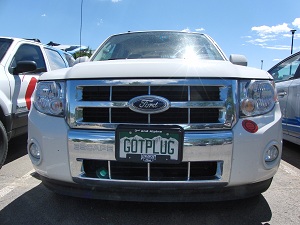Colorado town celebrates huge municipal solar project
 If you’ve ever been to Boulder, Colo., or at least seen pictures, it’s a small city that makes the rest of the world feel fat. People are perversely in shape. And as if making us hate our bellies wasn’t enough, Boulder has recently undergone an energy diet, which will save the city 5,722 metric tons of carbon dioxide emissions.
If you’ve ever been to Boulder, Colo., or at least seen pictures, it’s a small city that makes the rest of the world feel fat. People are perversely in shape. And as if making us hate our bellies wasn’t enough, Boulder has recently undergone an energy diet, which will save the city 5,722 metric tons of carbon dioxide emissions.
So under a nearly cloudless sky, Boulder celebrated the ribbon cutting of a new combination photovoltaic system, EV charging station, and solar thermal installation on the South Boulder Recreational Center on Aug. 15. The project is only one small piece of a 66-building project, undertaken by the City of Boulder.
The final price tag on the project, dubbed the Energy Performance Contract or EPC, is $12 million, but it is expected to save the city about $500,000 a year.
“Eventually, when we are through paying our loan, we’ll be able to reap those savings,” said Boulder’s Mayor, Susan Osborne. “It’s an absolutely marvelous thing.”
She spoke to a crowd of about 60 or so outside the recreation center.
Mayor Osborne said that most of the individual energy projects in the EPC will slash each building’s energy costs in half.
“The building behind us,” she said, “a 50-percent reduction in energy use.”
The system unveiled on Aug. 15 will not only provide energy savings for the center, but also power the two EV charging stations that were installed in the parking lot.
All three systems were installed and developed through a partnership of companies, including McKinstry, a developer with a focus on sustainability, and Namaste Solar, a Colorado solar installer.
“Here’s the remarkable thing about the City of Boulder: It didn’t wait,” said Ash Awad, McKinstry’s vice president of energy and facility solutions.
Awad said that, unlike many energy projects, especially at the Federal level, Boulder managed to streamline the process and get solar panels on the ground remarkably fast.
“I think if more communities took the initiative that’s happened here,” Awad said, “we would not necessarily need the federal government to act as aggressively as we eventually will need them to act.”
The project did come together quick, but not overnight.
“Quick is relative,” said Joe Castro, facilities and fleet manager for the City of Boulder. “We started this in 2009.”
The city started planning, analyzing, and auditing two years ago. Construction, however, began less than a year ago.
But what’s not expected to be as expedient is the time it will take to pay for the project.
Let’s do some simple math. A $12 million project, which generates about $500,000 a year, still has a payback time of 24 years, right?
Not quite.
“It’s actually a 13 to 15-year payout,” said Castro. “Altogether, 21 percent of that $12 million is other people’s money.”
He doesn’t mean friends of the mayor chipped in. He means ARRA funds, Xcel Energy rebates, and other private donors.
But the money isn’t spent yet. The city still has approximately 25 percent of the project to complete.
“We are looking at a phase three,” said Castro. “That looks like educational outreach. We’ve made the buildings energy efficient, but occupants can come in and modify controls, making things inefficient, and that’s why education and outreach are so important.”
Photo: Theo Romeo / Clean Energy Authority.



